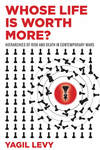 During the Second World War, the British government, with the invaluable assistance of Alan Turing, deciphered Enigma (the Nazi code war machine) and thus gained access to key information that helped win the war. In fact, it is calculated this reduced the war period by two years. But this discovery meant pretending not to know about some of the attacks the Nazis were planning, so the latter would not suspect anything. The moral dilemma this created, i.e. the sacrifice of some lives for the greater good, is still studied in numerous universities and philosophy classrooms.
During the Second World War, the British government, with the invaluable assistance of Alan Turing, deciphered Enigma (the Nazi code war machine) and thus gained access to key information that helped win the war. In fact, it is calculated this reduced the war period by two years. But this discovery meant pretending not to know about some of the attacks the Nazis were planning, so the latter would not suspect anything. The moral dilemma this created, i.e. the sacrifice of some lives for the greater good, is still studied in numerous universities and philosophy classrooms.
In his book “Whose Life is worth more? Hierarchies of risk and death in contemporary wars”, Yagil Levi makes the point that this dilemma is no longer a matter of discussion. In contemporary wars, it is widely held to be acceptable to kill a few for the greater good, especially if the justifications are good enough. In fact, Levi demonstrates that today, the sacrifice of the lives of combatants or non-combatants alike is no longer a matter of ethics or morals, but of legitimization. Using examples from the war politics of the United States, Britain and Israel in recent conflicts like the Yugoslavian Wars, Iraq War, or the Al-Aqsa Intifada (among others), Levi creates a complex, detailed and enlightening account of how the economy of lives works and changes in contemporary wars, and how these hierarchies are decided, justified and legitimized.
Levi creates a complex, detailed and enlightening account of how the economy of lives works and changes in contemporary wars, and how these hierarchies are decided, justified and legitimized.
Few authors would be brave enough to write this book. It is widely known that Israel and the United States do not take criticism of their military system lightly and respond to accusations of violating Human Rights with harsh claims of antipatriotism, and even terrorism. But who could be more legitimate to talk about what Israel and its historical allies have done than Yagil Levy? As the Vice-President of the Israeli Sociological Society and professor at The Open University of Israel, his work brings to the readers a new understanding of Israeli policies, and offers a clear view of the actions of the United States and Britain in the Middle East.
Levy’s book has unsurprisingly been called provocative and his objective honesty could be considered brutal, especially by those who are still convinced that wars can be heroic or that the military is an honourable institution. His methodological and empirical approach sheds light on the crude reality of how democratic states make decisions, directly affecting people’s chances of survival, in times of war. It also highlights their disturbing resemblance with global corporate companies, such as how employees who are considered as “non-vital” -generally the ones in lower-down positions- are the first to be fired (sacrificed) when the company is going through a crisis. Thanks to Levy’s thorough research and the vast quantity of official and non-refutable data he draws on, his reasoning is easy to follow and authoritatively undermines official narratives about war. Levi draws on the concepts of legitimacy, sacrifice, risk transfer and hierarchies to analyse detailed quantitative and qualitative informations. He shows how decisions made in the offices of politicians have a deep impact on the lives of those on the field, and highlights how little importance the loss of these lives seem to have in our contemporary world.
To read of how a soldier makes clinical decisions on which lives are worth sacrificing to legitimize a war operation is more frightening and eye opening than conventional war narratives which rely on pathos.
The book, mostly drawing on interviews and accounts of combatants involved in the conflicts, centers on those directly part of the strategic decision-making processes. This contrasts with the approach scholarship on war usually takes, which consists in focusing on soldiers or the civil population. Levy’s attempt to step away from what we could call sentimentalism is perfectly in tune with the spirit of the book. To read of how a soldier makes clinical decisions on which lives are worth sacrificing to legitimize a war operation, of how everything is reduced to the mathematics of power, is more frightening and eye-opening than conventional war narratives which rely on pathos.
Another remarkable point the book makes is how deaths are categorised and set in complex hierarchies. Often these hierarchies are overglossed and instead presented as a uniform mass: combatants and non-combatants. But Levi reveals the intricacies that underlie these classifications and denounces two key factors that directly affect the risk of death: racism and classism. The reader is made privy to how Black and Hispanic US soldiers coming from a poor background are more likely to be placed in a platoon that runs dangerous operations, or how Israel takes care not to expose the soldiers who come from a middle or upper-class background, or how the bombs fired by Hamas are more likely to hit the poorest Israelis, as they tend to live on the “frontier”. Levy also shows how Israel uses cultural notions and ethnonationalism to justify its actions against Palestinians – hence pointing to the importance of identity in death hierarchies. In fact, the book highlights how the (false) dichotomy between ‘us’ and the ‘others’ is mobilised alongside nationalism as one of the most powerful ways to justify armed conflicts.
Military tactics change and adapt to gain legitimization not only in the eyes of the military hierarchy but also in the public imagination.
Finally, Levi shows how legitimation works beyond the political or military world, and is articulated through many different external factors. The media, the families of the combatants, and public opinion (among others) play a big part in influencing which war policies will be devised. This gives the reader a deep understanding of how the “democratic” machine works and how military tactics change and adapt to gain legitimization not only in the eyes of the military hierarchy but also in the public imagination. One good example of this are the justifications given by the democratic party in the United State for their involvement in the Yugoslavian, the Afghan, and the Iraq Wars. Knowing that public opinion, especially their voter base, was against armed conflict, Clinton and Obama both justified these interventions as necessary humanitarian acts. Regarding the US involvement in Afghanistan, General McChrystal is quoted in the book saying: ‘Furthermore, the commitment was not only to defeat the Taliban but also to rebuild the Afghan state.’ (pp 204) and that ‘therefore, the goal was to separate insurgents from the people by reducing their capabilities and physically evicting many of them to protect key population centers and then expand the authority of the Afghan government’. (pp 205). The deployment of US troops in Afghanistan was hence presented as necessary to help Afghans defend themselves from the Taliban and gain their freedom. A freedom which is, and will likely remain for the foreseeable future, supervised by the United States military.
But the welfare of civilians and the establishment of democratic governments are not the only key arguments in legitimising wars. Technology has been gaining relevance as a method of validation. Levi highlights how the modernization of the armament is a key factor in the general public’s perception that contemporary wars are more humane than those of the first half of the twentieth century. Indeed, the fact that precise targeting can avoid innocent civil casualties – which also makes the legitimization of conflicts easier.
The modernization of the armament is a key factor in the general public’s perception that contemporary wars are more humane.
“Whose Life is Worth More’” is an exceptional tool for anyone looking to understand how hierarchies of life are at work in political conflicts and its resulting death tolls. But it is also a must-read manual for scholars interested in studying the consequences of war on civilians, specifically in the case of civil wars which are no longer raging but still impact society (for example, the Spanish Civil War). Understanding the narratives used to legitimate wars, their principal actors and the real numbers of casualties they leave behind can help us analyse the deep scars conflicts leave in the immediate and future social, cultural and psychological contexts.
Levy’s brilliant work forces us to ponder the mechanisms surrounding war, but more importantly, the mechanisms justifying death. As suggested by the image on the book’s cover, war is less far from a game of chess then we would probably like to think.
Levy, Yagil (2019). Whose Life is Worth More? Hierarchies of risk and death in contemporary wars. Stanford, California. Stanford University Press.
Featured Image: Enigma machine by Bob Lorde (cropped), found on Wikimedia Commons.



